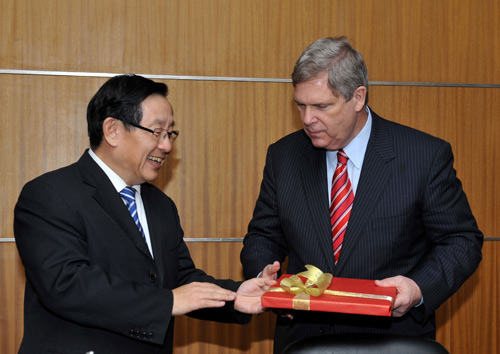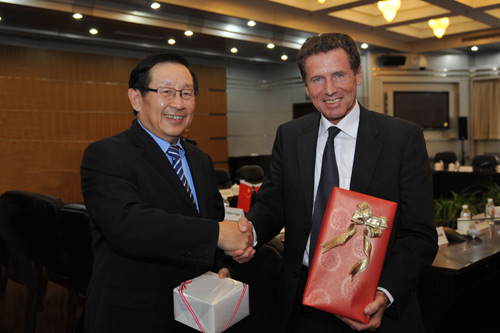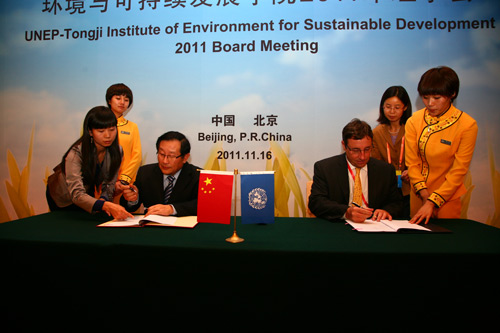CHINA SCIENCE AND TECHNOLOGY
NEWSLETTER
The Ministry of Science and Technology
People's Republic of China
|
|
|
N0.638 |
November 30, 2011 |
|
|
|
|
|
|
|
|
IN THIS ISSUE
|
|
*WAN Met with U.S. Guests
*MOST and UNEP Signed MOU
*WAN Met with IEA Head
* Antarctic Astronomical Observation
*Two Spacecrafts to Launch Next Year
* China Reduced 1.5 Billion Tons of Carbon in Five Years
* China Deploys Marine Seismographs in Antarctica
|
|
INTERNATIONAL COOPERATION |
WAN Met with U.S. Guests

November 18, 2011- WAN Gang, Chinese Minister of Science and Technology, met with visiting U.S. Secretary of Agriculture Tom Vilsack in Beijing. The two sides exchanged views on strengthening S&T cooperation in the area of agriculture, and staging flagship joint research projects. WAN said the bilateral S&T cooperation in the area of agriculture will not only benefit the two peoples, but will also help the international community deal with a range of common issues, including food security, climate change among others. In the past decade, the joint working group mechanism established by the Chinese Ministry of Science and Technology and the United States Department of Agriculture has played a positive role in fostering a close cooperation tie between research communities in the two countries in the areas of common interests, which has generated laudable accomplishments. WAN hoped that the two sides would work together to promote substantive collaborations on flagship projects as a next step, allowing the findings derived from joint agricultural researches to benefit the two peoples. Vilsack said S&T cooperation between the United States and China in the area of agriculture allows both sides to take full advantage of their respective strength, working together to address global challenges. The United States is willing to work with China on a range of flagship projects, covering agro-biotechnology, water-saving farming, gene bank collection techniques and associated practices among others.
After the meeting, WAN and Vilsack jointly undersigned a letter of intent on staging flagship joint research projects in the area of agriculture.
WAN Met with Austrian Guests

November 21, 2011- WAN Gang, Chinese Minister of Science and Technology, met with visiting Austrian Federal Minister of Science and Research Karlheinz Toechterle and Austrian Ambassador to China Martin Sajdik and their party. The two sides exchanged views on strengthening S&T cooperation between the two countries, particularly in the area of energy and environment technologies that are important for the sustainable development. WAN briefed the other side of China's 12th five-year planning (2011-2015)for science and technology development, and welcomed the Austrian side to work with Chinese industry, universities, and research community. Toechterle said Austria is willing to work on technology innovation with China under the framework of intergovernmental S&T cooperation, fostering a stable long-term cooperation tie, and making due contributions to enhancing the bilateral relations and S&T cooperation.
MOST and UNEP Signed MOU

WAN Gang, Chinese Minister of Science and Technology, attended a United Nations Environment Program (UNEP)-Tongji Institute of Environment for Sustainable Development (IESD) board meeting held on November 16, 2011, where WAN and UNEP Executive Director Achim Steiner jointly inked a Memorandum of Understanding between Chinese Ministry of Science and Technology and United Nations Environment Program.
WAN reviewed the collaborations between Chinese Ministry of Science and Technology and United Nations Environment Program in recent years. He said the two sides have laid a fine ground work for cooperation in the area of environmental technology, and shared a common vision for the future. The newly signed memorandum of cooperation will stage six cooperation projects during the period of 2011-2013, or the second three-year cooperation phase, covering water resources planning, water resources utilization, water resources related ecological protection, early droughts warning system and associated adaptation, dry land water saving farming, desertification control among others in Africa. The projects will be implemented through technical cooperation, technology transfer, capacity building, and a range of pilot projects for integrated demonstration park, research centers, and laboratories. The memorandum also supports the collaboration between Shanghai Municipal Government and UNEP on building an eco-island in Chongming, Shanghai. WAN said the South-South cooperation initiated to address climate change issues through scientific and technological means is a priority area where China are working with other developing countries and international organizations, including UNEP. Chinese Ministry of Science and Technology, in collaboration with UNESCO, UNDP, and UNEP, sponsored a South-South cooperation seminar on climate change in October 2011. MOST will release the second edition of South-South S&T Cooperation on Climate Change Adaptation Technical Manual at the upcoming United Nations climate change negotiations to be held in Durban, South Africa. China also opened a website for international S&T cooperation on climate change, with the involvement of UNEP as a partner. The two sides will strengthen cooperation in the above-mentioned areas.
WAN Met with IEA Head
November 17, 2011- WAN Gang, Chinese Minister of Science and Technology, met with Maria van der Hoeven, Executive Director of the International Energy Agency (IEA) and her party. During the meeting, WAN briefed the other side of China's clean energy technology R&D and associated demonstration/diffusion. WAN said China’s 12th five-year planning for science and technology development supports the development of a range of key technologies, equipment, and systems for clean coal, wind power, solar photovoltaic, solar thermal energy, new generation biomass energy, ocean energy, geothermal energy, hydrogen energy, new generation nuclear power, smart grid, and energy storage system among others. He added that China will work on the commercial application of wind power, efficient solar energy, biomass energy, and smart grids, and establish a brand new energy technology innovation system, strengthening the development of advanced proven technologies and models that would spur up new energy applications, combining the production, transportation and consumption of new energy in an effective manner, and promoting the sustained and rapid development of new energy industries. China also plans to work on a range of cutting edge technologies, including the fourth-generation nuclear energy technology, hydrogen energy and fuel cells, ocean energy, geothermal energy, and carbon dioxide capture, utilization and storage. Chinese Ministry of Science and Technology (MOST) expects to have more collaboration with the IEA in the area of energy technology, and hopes the IEA to report more about China’s efforts in promoting energy conservation and emission reduction. MOST will support more Chinese research institutions and experts to be part of IEA activities, and will send Chinese personnel to work for the IEA on a short-term basis.
Van der Hoeven briefed the Chinese side of the future strategic direction that the IEA will head for, strategic focuses of cooperation with China in the coming one or two years, and the highlights of the newly released "World Energy Outlook 2011". Van der Hoeven said MOST and the IEA have kept a good and solid communication tie, hoping the Chinese side will provide more information and data on energy R&D, and be an active part of energy technology cooperation under the framework of the IEA.
Crisp but Workable Rice Straw
Dr. LIU Binmei and coworkers at Chinese Academy of Sciences Hefei Institute of Physical Sciences managed to change the structure of paddy rice stems through ion beam mutagenesis, allowing the mutated rice stems to be crisp but resistant to lodging. The crisp stems can be easily smashed by a mechanical harvester, and turned into a fertilizer in the soil. Researchers placed rice seeds under ion beam irradiation, in a bid to change the lignin and cellulose content in stems. They harvested from the repeated experiments a mutant having a lodging resistant crisp stem, without affecting the leaves and grain. Further study shows that the crisp nature of the mutated stems is the combined result of a reduced cellulose content and an increased hemicellulose and lignin content.
To evaluate the potential applications of the mutant, researchers staged a large-scale field experiment in Feixi, Hefei. The paddy rice grown there were robust in growth and lodging resistant, with an increased yield by 5%. The new species saw no significant change in
pest resistance. The mutant straw stems can easily be smashed by a mechanical harvester, and 85% of the smashed straw stems would stand at a length less than 5cm, with the longest under 10cm. Meanwhile, crisp stems became more eatable as a livestock feed for animals raising industry.
Researchers said they are currently working on the field management part of growing the crisp paddy rice, including applicable fertilizer and pesticide dosages and growing methods, in an attempt to put the new technology into production applications.
Antarctic Astronomical Observation
It is reported from the Chinese Antarctic Astronomy Center that since the launch of astronomical observation in 2007 in Antarctica, Chinese scientists have harvested findings in the following areas.
1) China has established a reliable observing system at Dome A in Antarctica, a solid ground work laid for installing large astronomical telescopes and establishing an Antarctic Observatory there in the future. In the coming five years, China will become an important part of Antarctic astronomic observations, along with the installation of more observing equipment at the site;
2) After years of observation, Chinese astronomers have confirmed the status of Dome A as the best astronomical observation site in Antarctica. The local turbulent boundary layer is 14 meters above the ground on average, much closer to the ground, compared with other observatory sites across the Earth. That means the observing instruments will be able to make an observation directly through the turbulent boundary layer, enjoying a very stable seeing under an observation resolution up to 0.3 arcsec, extremely desirable for astronomical observation;
3) Chinese scientists conducted the first long-time accurate photometry of stars in Dome A, in a bid to test the feasibility of astronomic observation in Antarctica; and
4) Three-year astronomic observations in Dome A have resulted in rich weather, aurora, and astronomic data that could not have been obtained on other observatory sites, which are extremely useful for studying supernova cosmology, dark matter, formation of extrasolar planets and stars among others.
Two Spacecrafts to Launch Next Year
TONG Xudong, Head of China Aerospace Science and Technology Corporation Manned Space Engineering Office, told reporters that researchers are evaluating the spacecraft and launch vehicle systems after the completion of China’s first docking mission, and will check every details of the entire flight mission, so as to extract more useful information for the coming flight of two target spacecrafts (Shenzhou 9 and Shenzhou 10) in 2012. According to a plan, China will launch Shenzhou-9 in the first half of 2012, and Shenzhou-10 in the second half. The detailed launch timetable will be defined based on the assessment results of Shenzhou-8 mission, along with the work plan.
In the future, TONG said, Shenzhou spacecraft will mainly work on manned missions, though the daily necessities will mainly be delivered by a cargo ship that is currently under development. In addition, Chinese scientists are developing new generation launch vehicles for future spacecraft and space station launch.
According to TONG, Tiangong-I, a Chinese made target spacecraft, weighs 8 tons. A Chinese made space station in the future will be a core module plus two laboratory modules, weighing 20 tons each. The three modules will be assembled in space to be China’s first space station. Docking is a technique that one has to master as the launch vehicles so far developed have not yet been in a position to send the space station into space as a whole. In the future, China needs an 80-ton space station to accommodate the assembly of three modules, and docking of manned spacecraft and cargo ship.
China Reduced 1.5 Billion Tons of Carbon in Five Years
China Low-Carbon Economic Development Report (2012) recently released by the Chinese Academy of Social Sciences said China is not only the largest carbon emitter in the world, but also the largest carbon emission cutter in the world. During the period of 2005-2010, China reported a reduced GDP per unit of energy use by 19.1%, or 630 million tons of coal equivalent, or 1.5 billion tons of carbon.
The Report reviewed China’s accomplishments made in emission reduction and associated planning, and laid out an energy development roadmap for the country. The Report added that the core of China’s 12th five-year planning is to materialize a fundamental change in the development mode, encouraging a green and low-carbon oriented development. To take the low-carbon path, China has to achieve a range of binding targets, including a raised non-fossil fuel as a proportion of primary energy consumption by 11.4%, a reduced per GDP energy consumption by 16%, and a reduced per GDP carbon dioxide emission by 17%. The emission reduction will not be confined to sulfur dioxide only, but would rather include carbon dioxide emissions. These goals, when materialized, will significantly cut down China’s carbon dioxide and pollutants emissions.
China Deploys Marine Seismographs in Antarctica
China’s 28th Antarctic expedition team will for the first time deploy two Chinese made marine seismographs in the waters north of Prydz Bay, in an attempt to watch the seismic activities across the Antarctic continent and its surrounding waters.
According to KAN Guangming who is working for State Oceanic Administration No. 1 Institute of Oceanography, the deployed seismograph is made of a seismometer, a recorder, and a releaser. The seismometer built on a range of sensors is designed to convert the seismic waves received into electronic signals, and the recorder to collect and store the electronic signals. Researchers would recover the seismograph through the releaser, before getting the data from the recorder.
KAN said, according to the work plan, 'Snow Dragon' research vessel will deploy in early December the seismographs on the way to the Zhongshan Station, and have them recovered in early March 2012 on the journey home. The two seismographs are expected to record seismic activities in Antarctica and adjacent waters for 3 months. The data collected will be brought back to China for further analysis.
Probing seismic activities in Antarctica and adjacent waters will help scientists to improve their knowledge of the geological structures and associated evolution of deep Antarctic waters. To further probe the waters surrounding the Antarctic continent and associated geological evolution, the expedition team will conduct a marine gravity survey at the outer rims of the Antarctic waters using marine magnetometer and marine gravimeter.
Comments or inquiries on editorial matters or Newsletter content should be directed to:
Department of International Cooperation, MOST 15B, Fuxing Road, Beijing 100862, PR China Tel: (8610)58881360 Fax: (8610) 58881364
http://www.most.gov.cn

